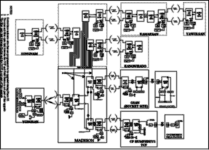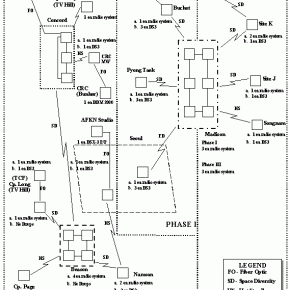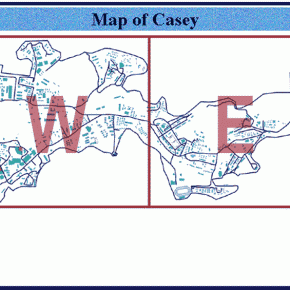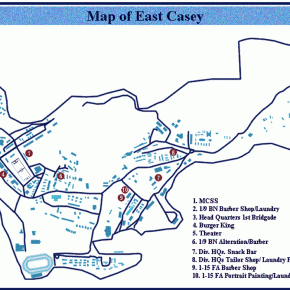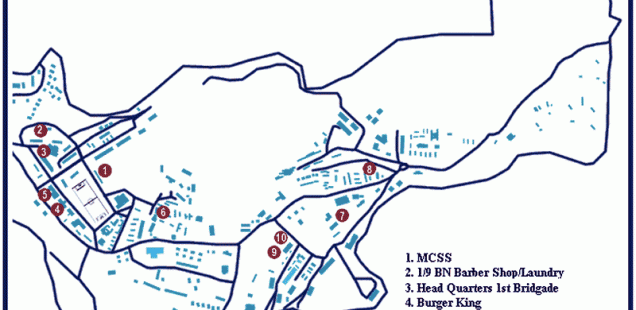
캠프 케이시(동두천)-영문2002/12/07 233
Camp Casey
US Army Garrison – Casey Enclave
37°55′N, 127°03′E
Camp Casey is located in Tongduchon, Korea approximately 40 miles North of Seoul. Camp Casey spanned nearly 3500 acres and was occupied by some 6300 military and 2500 civilians. Its primary mission is to act in concert with the Republic of Korea to deter aggression, and, should deterrence fail, to defend the ROK.
Hills and mountains cover about 75 percent of Korea, with the remainder covered by scattered lowlands. Most of the rivers are short, swift, and shallow due to topography, narrowness, and sand deposits within the river. Camp Casey was located within a valley, 11 miles (20 km) south of the Demilitarized Zone in the village of Tongduchon. The Kwangju Mountain Range, an offshoot of the Taebaek Mountains, extends southwest to include the mountains around Seoul. This range separates the Paju plain in the Imjin drainage from the Han. The majority of the mountain tops in this region are less than 4,900 feet (1,500 meters). Camp Casey is at the edge of Soyo Mountain, also known as Kyonggi’s “Little Kumkang Mountain.” It is the first gateway to the northern countries. It was also developing into the most important city in northern Kyonggi. The Tongduchun city population status was over 70,000 citizens. Its climate features included, on average, summers between 80 and 90 oF, winters between -5 and 30 oF, and 40-48″ of rain during a rainy season between July and August.
Camp Casey was one of the 42 camps north of Seoul authorized Hardship Duty Pay of $150 per month as of 1 January 2001. The Hardship Duty Pay is paid to troops who are permanently assigned to areas where it is authorized or who serve 30 consecutive days of temporary duty in those areas. Several factors are considered in determining whether a location qualified for the pay: climate, physical and social isolation, sanitation, disease, medical facilities, housing, food, recreational and community facilities, political violence, harassment and crime. The extra pay provides meaningful financial recognition to troops assigned in areas where living conditions are substantially below US standards.
Family Quarters are not available. All but 76 of the Division’s soldiers serve one-year unaccompanied tours. All soldiers live in on-post quarters.
Camp Casey was named and officially dedicated in 1952 in memory of Major Hugh B. Casey, who died in a plane crash in December 1951. Casey arrived in Korea in 1950, a Second Lieutenant, and served as a company commander in the 2nd Battalion, 7th Infantry Regiment, 3rd Infantry Division. He received the Distinguished Service Cross, the nation’s second highest award for valor, for heroism at the Hungnam beachhead. According to Lt. Colonel Roy E. Lewis, then executive officer of the 7th Infantry Division Support Command, Casey was ordered to have his company in a blocking position west of Hungnam by sunrise the next morning. He had to cross a mountain pass with 2 to 3 feet of snow in it. Force marching his men, he had them only halfway to the objective by sunrise. He pressed forward, refusing to give up despite the fatigue and hopelessness of the mission. He did not stop marching until ordered to. To Lewis, this was what made Casey an extraordinary soldier. “He gave little thought to himself,” Lewis said.
Later, while serving as senior aide to Maj. Gen. Williston B. Palmer, then Commanding General of the 3rd Infantry Division, Casey’s light observation plane was hit by ground fire. The plane crashed just west of what would become the 2nd Infantry Division headquarters. A white wooden cross was erected to mark the spot. This was replaced in 1960 by a white concrete cross. “Lest we forget,” the cross and camp now mark the memory of a brave man.
During the Korean War Camp Casey was home to the Royal Thai Battalion, the 19th Battalion Combat Team, Philippines, the US 45th Division, and the 5th and 7th Marines. On 21 March 1953, 1st Royal Australian Regiment was relieved by 2nd Royal Australian Regiment at Camp Casey, near Tongduchon, and returned to Australia later that month.
2nd Battle Group, 35th Infantry continued defense activity until 7 July 1953, when units of the Regiment were temporarily relieved of their combat mission, moved into I Corps reserve, and preceded to Camp Casey for rehabilitation and training. Here they remained until 10 September 1954 when the 35th Infantry Regiment began its return trip home to Hawaii as part of the 25th Infantry Division. In July 1953, the 25th Division again moved to reserve status at Camp Casey where it remained through the signing of the armistice 27 July 1953.
Between 1953 to 1971, the 7th Infantry Division defended the DMZ. Its main garrison was Camp Casey, South Korea. In 1954, the 7th Division occupied Camp Casey, Camp Hovey, and Camp Kaiser. In 1971, the 7th Division returned to the US and the 2nd Infantry Division moved from the Western corridor and occupied Camp Casey. In 1994, division headquarters transferred from Camp Casey to Uijongbu’s Camp Red Cloud, leaving the office of the Assistant Division Commander (Maneuver) in place.
With the creation of Installation Management Command (IMCOM) and the subordinate Installation Management Command Korea (IMCOM-K) in 2006 and subsequent reorganizations, Camp Casey became the headquarters for IMCOM’s US Army Garrison Casey Enclave. The Enclave under the Land Partnership Plan approved in 2002, would include Camp Castle and Camp Hovey along with Camp Casey, as a single administrative unit.
Central Post Information
Hospitals Available:
Dental Clinic
Health Clinic
Civilian hospital available on the economy for emergency care
MWR Facilities Available:
Recreation Center
1st Brigade Super day rooms
Library
Golf Course
Bowling Center
Swimming Pool
Outdoor Tennis/Basketball
Officer Club
NCO/Enlisted Club
Gymnasiums (2)
Arts & Crafts Center
Mini Gyms (5)
AAFES Facilities Available:
Post Exchange
Small Post Exchange
Burger King/Popeye’s
Airline Ticket Office
Tailor Shop
Shoppette
Class VI Store
Pizza Delivery
Filling Station
Barber/Beauty Salon
General Area Information
National Parks and Resorts: Tobong, Soyo and Surak Mountains are all in the area, as is the Songdu Resort. Also, there are many parks, resorts, historical sites and entertainment areas in Korea. Because of the country’s size and excellent transortation system, all these sites are within a day’s travel from anywhere in the Division area. On-post tour and travel offices, Morale, Welfare and Recreation offices, and the USO offer regular excursions.
Nearby Facilities and Places of Interest:
Hunting = Hunting available at Cheju-Do Island (320 miles away).
Fishing = Fishing by boat at Inchon (65 miles away).
Skiing = Chonmasan about 40 miles away from Camp Casey.
Swimming and Boating = No boating.
On post swimming pools.
FASTBACK
The FASTBACK system that was replaced in Korea is reflective of the typical legacy mw systems used by the US Army to support worldwide long haul communication requirements. The FASTBACK system (seven individual links) provided a secure reliable means of transmitting bulk data collected along the Demilitarized Zone to command groups located in the southern part of the country. The equipment (i.e., radios and multiplexers) supporting the FASTBACK system had been in operation for over fifteen years, utilizing technology that was over twenty years old. The FASTBACK system consisted of an AN/FRC-162 radio and AN/FCC-97 multiplexer. In the late 1990s it was replaced by a high speed (155 Mbps) SONET digital microwave radio that utilize the digital data multiplexer (DDM)-2000 OC3 multiplexer. The Digital Microwave Upgrade DMU Phase I is a good example of what occurs when the link bandwidth is increased (8 DS1s to 84 DS1s (three 45 Mbps DS3)) with high speed SONET digital microwave and interface requirements to existing older, low speed mw technology. The Yongsan to Madison, Osan to Madison, and Camp Humphreys to Madison FASTBACK links were replaced during Phase I with the Harris MegaStar 2000 SONET radio. The remaining FASTBACK mw links between Madison and Kamaksan, Kangwhado, and Songnam, and Kamaksan and Yawolsan, were replaced during DMU Phase III. In conjunction with the DMU, the digital patch and access systems (DPAS) at Yongsan, Osan, and Camp Humphreys were upgraded to support up to three DS3s each.
————————————————————————————-
Camp Casey
37°55′N, 127°03′E
Units
Assistant Division Commander (Support)
1st Brigade Headquarters
1st Battalion, 72nd Armor
2nd Battalion, 72nd Armor
1st Battalion, 503rd Infantry
2nd Battalion, 9th Infantry
Division Support Command HQ
702nd Main Support Bn
302nd Forward Support Bn
4th Chemical Company
122nd Signal Battalion HQ
A Company
B Company
1st Battalion, 15th Field Artillery
C Company, 5th Bn 5th AD Artillery
2nd Military Police Company
509th Personnel Services Battalion
177th Finance Battalion
Official Homepage
Camp Casey
——————————————————————————–
——————————————————————————–
Camp Casey is located in Tongduchon, Korea approximately forty miles North of Seoul. Camp Casey spans nearly 3500 acres and is occupied by some 6300 military and 2500 civilians. Hills and mountains cover about 75 percent of Korea, with the remainder covered by scattered lowlands. Most of the rivers are short, swift, and shallow due to topography, narrowness, and sand deposits within the river. Camp Casey is located within a valley, 11 miles (20 km) south of the Demilitarized Zone in the village of Tongduchon. The Kwangju Mountain Range, an offshoot of the Taebaek Mountains, extends southwest to include the mountains around Seoul. This range separates the Paju plain in the Imjin drainage from the Han. The majority of the mountain tops in this region are less than 4,900 feet (1,500 meters).
Camp Casey was named and officially dedicated in 1952 in memory of Maj. Hugh B. Casey, who died in a plane crash here in December 1951. Casey arrived in Korea in 1951, a Second Lieutenant, and served as a company commander in the 2nd Battalion, 7th Infantry Regiment, 3rd Infantry Division. He received the Distinguished Service Cross, the nation’s second highest award for valor, for heroism at the Hungnam beachhead. According to Lt. Col. Roy E. Lewis, then executive officer of the 7th Infantry Division Support Command, Casey was ordered to have his company in a blocking position west of Hungnam by sunrise the next morning. He had to cross a mountain pass with two to three feet of snow in it. Forcemarching his men, he had them only halfway to the objective by sunrise. He pressed forward, refusing to give up despite the fatigue and hopelessness of the mission. He didn’t stop marching until ordered to. To Lewis, this was what made Casey an extraordinary soldier. “He gave little thought to himself,” Lewis said. Later, while he was serving as senior aide to Maj. Gen. Williston B. Palmer, then Commanding General of the 3rd Inf. Div., Casey’s light observation plane was hit by ground fire. The plane crashed just west of the present 2nd Infantry Division headquarters. A white wooden cross was erected to mark the spot; it was replaced in 1960 by a white concrete cross. “Lest we forget,” the cross and camp now mark the memory of a brave man.
Camp Casey is one of the forty-two camps north of Seoul authorized Hardship Duty Pay of $150 per month as of 01 January 2001. The Hardship Duty Pay is paid to troops who are permanently assigned to areas where it is authorized or who serve 30 consecutive days of temporary duty in those areas. Several factors are considered in determining whether a location qualified for the pay: climate, physical and social isolation, sanitation, disease, medical facilities, housing, food, recreational and community facilities, political violence, harassment and crime. The extra pay provides meaningful financial recognition to troops assigned in areas where living conditions are substantially below US standards.
Family Quarters are not available. All but 76 of the Division’s soldiers serve one-year unaccompanied tours. All soldiers live in on-post quarters. See the quality of life and unit-specific pages for more information on recent barracks upgrades and construction projects.
Nearest Towns/Large Urban Areas
Tongduchon
0 Miles
Population 70,000
Seoul
40 Miles
Population 11,000,000
Camp Casey is located in Tongduchon, just 40 miles north of Seoul. TONGDUCHON, located on the most northern part of Korea, is at the edge of Soyo Mountain, also known as Kyonggi’s “Little Kumkang Mountain.” It is the first gateway to the northern countries. It is also developing into the most important city in northern Kyonggi. The Tongduchun city population status is over 70,000 citizens.
General Area Information
Climate :
Summer = 80.0 to 90.0F Average
Winter = -5.0 to 30.0F Average
Precipitation = 40-48″ (Rainy season July to August)
Nearby Facilities and Places of Interest :
Hunting = Hunting available at Cheju-Do Island (320 miles away).
Fishing = Fishing by boat at Inchon (65 miles away).
Skiing = Chonmasan about 40 miles away from Camp Casey.
Swimming and Boating = No boating. On post swimming pools.
National Parks and Resorts : Tobong, Soyo and Surak Mountains are all in the area, as is the Songdu Resort. Also, there are many parks, resorts, historical sites and entertainment areas in Korea. Because of the country’s size and excellent transortation system, all these sites are within a day’s travel from anywhere in the Division area. On-post tour and travel offices, Morale, Welfare and Recreation offices, and the USO offer regular excursions.
Central Post Information
Base Size : 3487.3 Acres
Population of the Post : approx. 8,800
Military = Approx. 6,300
Dept. of the Army civilians = 2,500
Other = 0
Primary Mission of the Installation : To act in concert with our Korean allies to deter aggression, and, should deterrence fail, to defend the Republic of Korea.
Supported Units :
Assistant Division Commander (Support)
1st Brigade Headquarters
1st Battalion, 72nd Armor
2nd Battalion, 72nd Armor
1st Battalion, 503rd Infantry
2nd Battalion, 9th Infantry
Division Support Command Headquarters
-702nd Main Support Battalion
-302nd Forward Support Battalion
-4th Chemical Company
122nd Signal Battalion
- Headquarters and Headquarters Company
- A Company
- B Company
1st Battaltion, 15th Field Artillery
C Company, 5th Battaltion 5th Air Defense Artillery
2nd Military Police Company
509th Personnel Services Battalion
177th Finance Battalion
Location of the Post : Camp Casey, Tongduchon City, Republic of Korea. Camp Casey, as well as Camp Hovey, Camp Garry Owen and Camp Greaves are all located near each other, just south of the DMZ (Demilitarized Zone). The camps are about two hours out of the capital city of Seoul.
Hospitals Available :
Dental Clinic
Health Clinic
Civilian hospital available on the economy for emergency care.
MWR Facilities Available :
Recreation Center
1st Brigade Super day rooms
Library
Golf Course
Bowling Center
Swimming Pool
Outdoor Tennis/Basketball
Officer Club
NCO/Enlisted Club
Gymnasiums (2)
Arts & Crafts Center
Mini Gyms (5)
AAFES Facilities Available :
Post Exchange
Small Post Exchange
Burger King/Popeye’s
Airline Ticket Office
Tailor Shop
Shoppette
Class VI Store
Pizza Delivery
Filling Station
Barber/Beauty Salon
